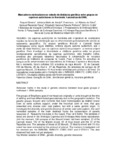Please use this identifier to cite or link to this item:
http://www.alice.cnptia.embrapa.br/alice/handle/doc/528745| Title: | Marcadores moleculares no estudo de distância genética entre grupos de caprinos autóctones do Nordeste: I-amostras de DNA. |
| Authors: | SILVEIRA, R.  ARAÚJO, A. M. de   SILVA, F. L. R. da   PAIVA, S. R.   PINHEIRO, E. S. P.   COSTA, M.   |
| Affiliation: | ADRIANA MELLO DE ARAÚJO, CNPC FRANCISCO LUIZ RIBEIRO DA SILVA, CNPC SAMUEL REZENDE PAIVA, CENARGEN ELIZABETH SARAIVA PEIXOTO PINHEIRO MÁRCIO COSTA. |
| Date Issued: | 2006 |
| Citation: | In: SEMANA DA CAPRINOCULTURA E DA OVINOCULTURA BRASILEIRAS, 5., 2006, Campo Grande, MS. Palestras e resumos. Campo Grande, MS: Embrapa Gado de Corte; Embrapa Caprinos, 2006. Seção resumos. 4 f. 1 CD-ROM. |
| Description: | Resumo: Os caprinos autóctones do Nordeste são originários de exemplares trazidos na época da colonização que se diferenciaram genotipicamente devido ao isolamento geográfico. Os grupos genéticos Moxotó e Canindé foram homologados como raças distintas, embora alguns autores sustentem, sob o ponto de vista histórico, que os caprinos autóctones possuem a mesma origem genética. Para investigar a diversidade e distância genética entre os grupos fenotipicamente semelhantes de caprinos autóctones, este trabalho colheu amostras dos principais rebanhos destinados à conservação de recursos genéticos de institutos de pesquisa no Ceará, Piauí e Bahia. As amostras de sangue estão armazenadas nos laboratórios da Embrapa Caprinos e Meio-Norte. Até o momento, foram colhidas 100 amostras da raça Moxotó, 32 da Canindé, 152 da Marota, 45 da Azul e 37 da Repartida. As amostras de sangue de 25 caprinos Moxotó, 25 Marota e 10 Azul foram extraídas pelo protocolo do fenol. Os marcadores investigados até o momento são o INRA006, INRA172, CSRC 0247 e ILSTS011. Os dados obtidos ainda não foram analisados. Molecular marks in the study of genetic distance between local goats groups of northwest: I. DNA samples. Abstract - The groups of Brazilians goat of northeast are originally of units brought at the time of settling and had differentiated geenotipicaly due to the geographic isolation. The genetic groups MoxotÛ and Canindé had been homologated as distinct breed. Even so some authors support, under the historical point of view, that goat presented only diverse color coat pattern, but with a same genetic origin. To investigate the diversity and genetic distance of similar coat color pattern, this work harvested samples of the main destined flocks the conservation of genetic resources of Researchs Institutes in the Cear·, PiauÌ and Bahia. The samples of blood are stored in the Embrapa Caprinos and Embrapa Meio-Norte laboratories. Until the moment, 100 samples of the MoxotÛ breed had been sampled, 32 of the CanindÈ breed, 152 of the Marota breed, 45 of Azul breed and the 37 of the Repartida one. The samples of blood of 25 MoxotÛ, 25 Marota breed and 10 Azul breed has been extracted by the protocol of phenol. The markers investigated until the moment are the INRA006, INRA172, CSRC 0247 and ILSTS011. The data observed had been not yet analyzed |
| Thesagro: | Caprino DNA Genética Molecular Marcador Molecular Recurso Genético |
| NAL Thesaurus: | Goats Genetic markers Genetic distance Brazil |
| Keywords: | Diversidade genética Genetic diversity Isolation of DNA |
| Notes: | Título em inglês: Molecular marks in the study of genetic distance between local goats groups of northwest: I. DNA samples. |
| Type of Material: | Artigo em anais e proceedings |
| Access: | openAccess |
| Appears in Collections: | Artigo em anais de congresso (CNPC)  |
Files in This Item:
| File | Description | Size | Format | |
|---|---|---|---|---|
| AACMarcadoresmoleculares.PDF | 57.81 kB | Adobe PDF |  View/Open |









